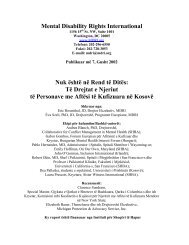Torture not Treatment - Disability Rights International
Torture not Treatment - Disability Rights International
Torture not Treatment - Disability Rights International
Create successful ePaper yourself
Turn your PDF publications into a flip-book with our unique Google optimized e-Paper software.
TORTURE NOT TREATMENT<br />
A flat ban on the use of electricity or long-term use of restraints to treat or modify behavior<br />
would be the best way to prevent future abuse. Such a ban would be consistent with federal<br />
policy and best practice in the field of behavior modification that strongly supports positive<br />
behavioral supports instead of painful aversives. Such a ban would be consistent with what CAT<br />
has called for to protect people in custody in a law enforcement context. In 2000, as described<br />
above, CAT recommended that the United States ―abolish electro-shock stun belts and restraint<br />
chairs as methods of restraining those in custody since ‗their use almost invariably leads to<br />
breaches of article 16 of the Convention [defining inhuman and degrading treatment].‘‖ 226<br />
This year, CAT will be conducting its fifth periodic review and report of the United States of<br />
America and its compliance with the UN Convention against <strong>Torture</strong>. In its last review of the US<br />
in 2006, CAT‘s report made a number of recommendations to the US government with regard to<br />
torture, including a concern they voiced over the use of electro-shock devices: “restricting it to<br />
substitution for lethal weapons and eliminate the use of these devices to restrain persons in<br />
custody…” 227 In this year‘s review by CAT, in their list of issues of concern, they again bring up<br />
the use of electro-shock devices and ask the government if they have restricted its use as a<br />
substitution for lethal weapons only, as recommended in CAT‘s previous observations. And they<br />
ask point blank, ―Are such devices still used to restrain persons in custody?‖ 228 CAT has also<br />
asked for updated information on steps taken to ―address the concern about the conditions of<br />
detention of children‖ with a particular emphasis on the use of excessive force. 229 And finally<br />
CAT asks:<br />
Please describe steps taken to end the practice of corporal punishment in schools, in<br />
particular of mentally and/or physically disabled students. 230<br />
This year, the United States human rights record is being scrutinized by the United Nations as<br />
part of a process known as ―universal periodic review‖ under all the human rights conventions<br />
the United States has ratified. The United States report to the United Nations should include<br />
detailed information on the use of force against children with disabilities at JRC.<br />
Since the United States legal system has failed to protect children and adults with disabilities,<br />
MDRI brings this urgent appeal to the UN Special Rapporteur on <strong>Torture</strong> and<br />
recommends:<br />
<br />
<br />
<br />
<br />
The UN Special Rapporteur on <strong>Torture</strong> should demand a full international accounting by<br />
the United States government of the abusive practices being perpetrated at the facility;<br />
The use of electric shock and long-term restraints should be brought to an immediate halt<br />
as a form of behavior modification or treatment;<br />
New federal law should be adopted to completely ban the infliction of severe pain for socalled<br />
therapeutic purposes in any context;<br />
<strong>Torture</strong> as treatment should be banned and prosecuted under criminal law.<br />
42




